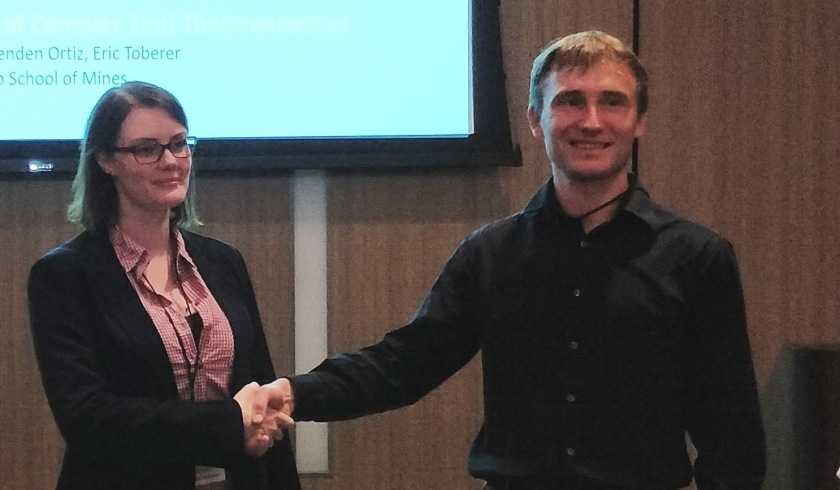Poster award to HZB doctoral student

Andriy Zakutayev (NREL), member of the jury, has awarded Fredrike Lehmann for her poster at ICTMC-21 in Boulder, Colorado, USA.
Frederike Lehmann from the HZB Department Structure and Dynamics of Energy Materials received a poster award at an international conference, the ICTMC-21 in Boulder, Colorado, USA. She presented her results on the synthesis and characterization of hybrid perovskite materials, which are considered interesting candidates for novel solar cells.
Frederike Lehmann is doing her doctorate at the HyPerCell graduate school in the department of Prof. Dr. Susan Schorr on different hybrid perovskite materials. This class of materials is extremely interesting for novel and inexpensive solar cells.
Frederike Lehmann does not only produce these materials using various synthesis methods, but also characterizes their structure and analyzes their optical and electronic properties. "I am also trying to modify these properties through targeted doping or substitution of certain elements in hybrid perovskites by other elements or chemical building blocks," explains Lehmann. For example, with the goal to vary the band gap and simultaneously increase the material stability in order to optimise those materials for solar cells.
At the 21st International Conference on Ternary and Multinary Compounds (ICTMC-21), which took place in Boulder, Colorado, USA, in September, Frederike Lehmann presented her work with a poster and received an award for her contribution.
Title of the poster: „Stabilizing the cubic phase of the triple cation hybrid perovskite (FA1-xMAx)1-yCsyPbI3 solid solution”
Conference website: https://sites.google.com/view/ictmc21/home
arö
https://www.helmholtz-berlin.de/pubbin/news_seite?nid=14958;sprache=en
- Copy link
-
Long-term stability for perovskite solar cells: a big step forward
Perovskite solar cells are inexpensive to produce and generate a high amount of electric power per surface area. However, they are not yet stable enough, losing efficiency more rapidly than the silicon market standard. Now, an international team led by Prof. Dr. Antonio Abate has dramatically increased their stability by applying a novel coating to the interface between the surface of the perovskite and the top contact layer. This has even boosted efficiency to almost 27%, which represents the state-of-the-art. After 1,200 hours of continuous operation under standard illumination, no decrease in efficiency was observed. The study involved research teams from China, Italy, Switzerland and Germany and has been published in Nature Photonics.
-
Energy of charge carrier pairs in cuprate compounds
High-temperature superconductivity is still not fully understood. Now, an international research team at BESSY II has measured the energy of charge carrier pairs in undoped La₂CuO₄. Their findings revealed that the interaction energies within the potentially superconducting copper oxide layers are significantly lower than those in the insulating lanthanum oxide layers. These results contribute to a better understanding of high-temperature superconductivity and could also be relevant for research into other functional materials.
-
Electrocatalysis with dual functionality – an overview
Hybrid electrocatalysts can produce green hydrogen, for example, and valuable organic compounds simultaneously. This promises economically viable applications. However, the complex catalytic reactions involved in producing organic compounds are not yet fully understood. Modern X-ray methods at synchrotron sources such as BESSY II, enable catalyst materials and the reactions occurring on their surfaces to be analysed in real time, in situ and under real operating conditions. This provides insights that can be used for targeted optimisation. A team has now published an overview of the current state of knowledge in Nature Reviews Chemistry.
